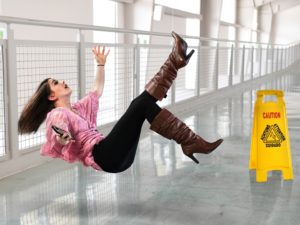
The short answer is an emphatic yes. In fact, some safety experts use science in lecturing on slip, trip, and fall prevention strategies. At times, it’s a matter of momentum and gravity. Surely, you remember those terms from grade school science classes.
One out of state medical provider actually provides patient education on avoiding slips, trips, and falls, and explains the forces that add to accidents:
- Friction: Friction and traction are synonymous terms when it comes to slip and fall actions. They involve the resistance that happens when your footwear meets the ground surface. When you make an injury claim related to this type of accident, defense counsel will request information regarding your shoes for this reason.
- Momentum: Your weight and speed contribute to how hard you fall. As you might guess, the faster you are traveling, together with your body size may mean you fall harder. For a moment, think of the difference between an adult and a child descending down a water slide. Who makes the bigger splash?
- Gravity: You could always blame your fall injuries on gravity. After all, it’s “the force that’s with you,” that causes the downward motion. Otherwise, you might float instead of landing on the ground.
Medical Journal Describes More on Slip and Falls
Now that you understand the basics, you might enjoy some more in-depth knowledge. At least one medical journal article provides insight regarding fall causation on flat surfaces. Actually, the focus of the presentation relates to the prevention of occupational injuries.
If you work in a warehouse, factory, or restaurant, your employer generally requires you to wear skid-resistant shoes. Once again, that’s because slip and fall accidents happen more frequently when you can’t “counteract the forward or rearward forces that occur during the stepping process.”
As an aside, your failure to wear the proper footwear does not mean you can’t make a workers’ compensation claim if you slip and fall on the job. (That said, the boss may write you up for failure to comply with company policy.)
Resistance Analysis
The resistance analysis goes further than you might think. For example, a “micro slip” differentiates in length from a “slip.” Meanwhile, a “slide” means you could not control your heel movement and slipped more than 10 cm. The latter results in most falls.
When you slip or slide, you fall forward. However, you could also trip and fall. According to scientific evidence, trips occur “when the swing phase of the foot is interrupted unexpectedly due to inadequately clearing the ground.” When you trip, you fall in a backward motion.
Work-related accidents prove the exception when it comes to establishing that someone else caused your injuries. (Your entitlement to workers’ compensation benefits does not require evidence of fault.)
When experienced personal injury attorneys handle these types of claims, they often retain the engineering experts to secure their opinions. In the next part of our series on slip and fall accidents, you can learn more about how they contribute to proving your claim.
Contact Us
The Law Offices of Anthony Carbone handles personal injury claims of all types. Whether you fell at work or due to hazardous conditions, we can help you. Not only is there no cost to meet with us, but we are not paid unless we secure damages on your behalf. Call us at 201-762-8956 and let us know your availability to discuss the circumstances of your fall.